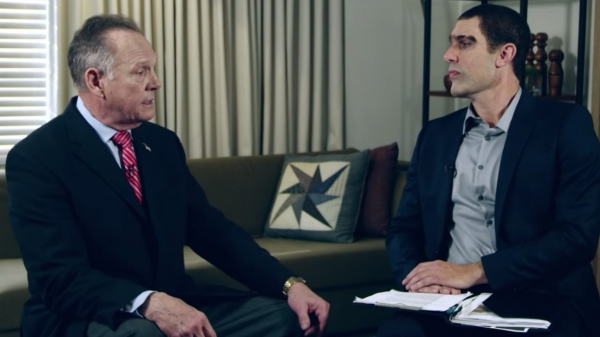The defense has rested in the defamation trial between Roy Moore and accuser Leigh Corfman after a day of testimony primarily devoted to Moore’s character.
Moore once again took the witness stand on Monday after multiple character witnesses from Moore’s home community of Gallant.
Moore once again denied knowing Leigh Corfman and ever taking her to his house and initiating sexual contact with her.
Corman alleges that Moore touched her over her bra and panties in 1979, when she was 14 years old and he was 32. The allegations were the centerpiece of a 2017 Washington Post article that shook up the special U.S. Senate election between Moore and Democrat Doug Jones, who ultimately won the race.
In statements after the article’s publication, Moore referred to the allegations as “dirty politics” and again Monday testified that the allegations were “purely political.”
“I never knew Ms. Corfman,” Moore told his attorney, Julian McPhillips. “I never knew her, never took her to my home, she was never in my car. I didn’t telephone her. I didn’t see her in the courthouse. I don’t know her.”
Both Corfman and her mother, Nancy Wells, previously testified that they first met Moore at the Etowah County Courthouse while Wells waited to go into a child custody hearing to transfer custody of Corfman to her father. They testified that Moore introduced himself and told Wells that Corfman didn’t need to go into the hearing regarding her own custody, and offered to sit outside on the bench with her. Corfman testified that Moore asked for her number while Wells was in the hearing.
When pressed by Corfman attorney Melody Eagan on Monday, Moore once again stated that he never met Corfman at the courthouse.
But after the defense rested, Eagan told Judge John Rochester that the plaintiffs would like to call two more witnesses before transitioning to closing arguments. One of those witnesses will be Gadsden lawyer Charlie Boyd, who Eagan said is expected to testify that he saw Moore and Corfman together outside the custody hearing.
The defense counsel took issue to the late addition of the witnesses.
“This greatly breeches protocol,” McPhillips said, arguing that the witnesses were sprung on the defense after they had already rested. Rochester told McPhillips he has been very open to allowing witnesses throughout the trial, pointing to several witnesses the defense was able to examine despite objections from the plaintiffs.
A snapshot of the Moore house in 1979?
The second witness will be an expert testifying to the dating of Polaroid photos, and is expected to date a specific polaroid that became a focal point of testimony on Monday.
The photo shows Moore’s trailer home that, according to Moore, was taken around 1979. Moore found the photo just a few weeks before trial and Eagan questioned Moore about the convenience of the timing.
Corfman’s attorney’s have several times reiterated that Moore could not recall the details of his house in 1979 during depositions taken in 2018, 2019 and 2020. Monday, they also revealed that Moore testified in the same depositions that he had been unable to locate a photo of the house at the time despite a “thorough search” through some 30 photo albums.
“I found it in a stack of things off to the side and when I found it, I immediately told my counsel and there was a deposition after that,” Moore said.
Eagan also asked Moore whether he had a meeting with family including his wife, Kayla, and sister Tony Martin on Jan. 8, 2022 to go over details of the house after finding the photograph.
Moore said he did meet with them, but planned the meeting before he found the photo.
Martin had testified earlier in the morning including some of the most specific details about the state of Moore’s house in 1979 yet in the trial.
Some of that testimony conflicted with Corfman’s earlier testimony about her recollection of the house. Specifically, Martin testified that Moore did not have a TV in his home in 1979 — she said he didn’t have one until the 1990s.
She recalled moving in across the street from Moore in 1979 and spending New Year’s Eve night of that year at the home. The next day, the family teased the thought of staying one more night, but she remembered Moore joking that it wouldn’t happen because “Dennis,” one of the relatives staying over, would want to watch the 1980 Sugar Bowl between Alabama and Arkansas.
She also said she knew Moore never drank, although she later conceded that he may have drank on occasion but she never knew him to drink. Moore himself testified that he sometimes drank wine, but never liked the taste of beer or hard liquor and never kept beer in his refrigerator. Corfman had testified that he had beer in his fridge on one of her two visits to the home and that she had chosen to drink a beer.
Martin also talked about Moore’s two German Shepherds and the dog pens on the property that Moore used to keep them in. The dogs were not mentioned in Corfman’s testimony about going to Moore’s house.
Moore also testified that Corfman’s testimony that he had a gravel driveway was incorrect (it was dirt) and that there was no tile in the kitchen as well as no privet fence.
The expert witness, Eagan said, is expected to testify that the photo is not actually dated 1979.
Moore has stated multiple times under questioning from Corfman’s attorneys that the house was constantly changing and that the testimony of multiple women who claim to have visited the house would have been different based on the timing that they visited the home.
Moore drives home primary arguments
Moore reiterated during his testimony many things that had previously been expressed in the trial. He said in multiple campaigns over more than a decade, no allegations of this sort had ever come up despite opposition from both the opposing political party and his own party.
He said his denials were not tantamount to defamation as they were pointed at the allegations themselves and not Corfman.
He also distinguished between calling Corfman a liar and calling her allegations lies.
“If I say you’re a liar that means you don’t tell the truth anywhere, anytime, anyplace,” Moore said. “That’s defamatory in some situations. If I say you’re not telling the truth about some specific fact, that’s limited. If I say your allegations are false and malicious, that’s specific. That’s not criticizing the general character or reputation.”
The defense once again brought up Richard Hagedorn, who allegedly tipped off the Washington Post to the story, claiming Hagedorn had reason to dislike Moore.
Moore said he once held Hagedorn in contempt of court for failure to pay child support and failure to pay alimony and also once again stated that Hagedorn’s brother was married by U.S. Supreme Court justice Ruth Bader Ginsburg. Once again, Rochester sustained an objection to Hagedorn’s brother being relevant.
At one point McPhillips read a long list of explicit messages sent to Kayla Moore through email and social media, which Moore said were also presented to him. The comments called him a pervert, a pedophile, a child molester and many other things of a more explicit nature even accusing him of incest in one case.
The defense said it was demonstrating the damage of Corfman’s allegations for the jury.
The ‘godly man’ of Gallant
Before Moore took the stand for several hours in the afternoon, the defense brought a revolving door of mostly character witnesses forward to testify for Moore. Most were from his small unincorporated community of Gallant about 25 minutes outside of Gadsden.
Connie Wilkerson, who was 16 years old in 1979, said in Gallant, “everybody knows everything about everybody, sometimes before they know it.”
“Facebook has nothing on Gallant,” she said.
And yet, she testified to never hearing anything bad about Moore until “he was on Hannity.” In fact, she testified she trusted him enough to leave him in charge of her down syndrome son to teach him to swim.
“That made him a hero to me,” Wilkerson said.
Linda Chandler of Gallant said she believes Moore to be “one of the most godly men that I have ever known.”
She also said that she “would have heard something” about Moore being inappropriate with young girls in her position in a doctor’s office, but she never did.
Tina Gargus, former postmaster in Gallant, said Moore is “one of the best men I’ve ever met. I couldn’t put him up against anybody else.”
Jana Mayo said she played on the Gallant girls softball team when she was 11 years old and was coached by Moore.
“He was never inappropriate,” Mayo said. “He was all ball.”
Elaine Watson said she worked with Moore at First Alabama Bank when she was 16 in 1976, and frequently worked alone with him in the three years they worked together. She said he never did anything to make her uncomfortable and never heard any rumors of him being inappropriate.
In addition to testifying about the appearance of her brother’s home in 1979, Martin testified about Moore being a father figure in her life.
“My farther died when I was 8,” Martin said. “(Moore) was the perfect example of a fatherly figure.”
She testified he was often around her and her friends and never made them uncomfortable, teaching several of them to swim and to drive.
Jimmy Flanagan, formerly a police captain in Gadsden, said he met Moore in the 1970s and never heard any kind of rumors that Moore was inappropriate with young girls.
“His passion for the law, and passion for truth is beyond reproach for me,” Flanagan said. “I would believe anything Judge Moore told me.”
Leonard Holifield was Moore’s bodyguard during his time on the Alabama Supreme Court as well as for several years after his removal.
He testified that in yers of traveling with Moore across the country, he never observed any inappropriate behavior by Moore or heard any whispers of misconduct.
“He’s a solid guy, honest guy, high-integrity, professional,” Holifield said.
Randy Waters testified to meeting Corfman on the scene of a wreck and asking her for her name. Waters was a firefighter responding to the scene.
“You know me, I’m Leigh Corfman,” Waters said Corfman told him. He responded that he did not know who she was.
“You know. I’m the 14-year-old who said Roy Moore molested me,” Waters said Corfman followed with. He also testified to hearing her tell several other responders that she was the accuser of Roy Moore.
Recounting Moore’s past
The defense spent a good deal of time going back through Moore’s time on the Alabama Supreme Court and his behavior during the controversies that led twice to his eventual removal as chief justice.
Moore said his display of the Ten Commandments was part of a larger display addressing the foundation of good law in the laws of God.
There was also a continuation of racially charged testimony to the all-Black jury, speaking to Moore’s placement of plaques honoring Martin Luther King Jr. and Frederick Douglass. Moore spent several minutes speaking about the quotes of the men which remain on display in the court house and how they acknowledge God’s law as the basis for all law. The defense also talked about Moore working to bring the court out of racial inequality and Moore began speaking about the Scottsboro Boys ruling before the trail was cut off by objection to relevance. He also testified about a Black man sentenced to first-degree robbery for shoplifting a nailgun, which he said he opposed to some consternation from other justices. This line of testimony was also cut short by an objection.
The plaintiffs previously pointed to a quote Moore made about Black families being stronger during slavery, to much ire from Moore despite him restating that all families were stronger during that time.
The defense also got Moore talking about his writing of Alabama’s statute on child abuse and his prosecution of the first ever case to use the statute in the state.
Soundbites
McPhillips told the judge, absent the presence of the jury, that the allegation that Moore touched Corfman on the outside of her bra is “something that people do by accident all the time.”
He also called the plaintiffs’ evidence as all “smoke and mirrors” and once again called on Judge Rochester to dismiss Corfman’s claim. Rochester denied the motion but said he would consider it overnight.
After several rounds of objections while Moore was testifying to finding Hagedorn in contempt of court, Rochester warned McPhillips that if the offending line of questioning continued, he would end the trial and go on into closing arguments.
The trial could conclude today with the examination of the final two witnesses for the plaintiff and closing arguments for each side.





















































